
One-third of small businesses start with less than $5,000, but if you want your business to grow, you’re going to need a lot more than that. (Wood, 2020). Small business entrepreneurs of old used to go to the bank to secure a loan. Luckily, you have more options to find funding because of our evolving, digital world. There’s no need to dust off the shoebox of spare cash under your bed to fund your dreams. Between rent, salaries, digital advertising, product development, and everything else involved with starting a business, you’d sure need a lot of shoeboxes! There are so many options for finding funding that you might think you need to be an expert to figure out which one is right for you, but as Marcus says, “You don’t have to be a genius to run a successful small business, but you better be smart enough to be willing to learn.”
Why Raising Capital is so Important
Before we dive into the nitty-gritty, it’s key to know why raising capital is so valuable for small-business owners. It’s almost as important as knowing how to raise capital. These are our top three reasons why learning to raise capital for business is so important.
Credibility
As an entrepreneur, your reputation might be the only thing you can rely on for a while. When you get a cash infusion, you’re marrying your interests to an investor or a more well-established company. It’s like they’re saying that they checked you out and you’re on the level. That kind of backing can help open doors. Raising money isn’t the only way to raise capital for business. Sometimes raising your reputation can be just as valuable to a startup.

Resources & Connections
More than just a cash infusion, capital can also mean brain capital. That’s what many entrepreneurs miss when they ask how to raise capital for business. Your investors have an interest in helping you succeed, so they may introduce you to their partners, manufacturers, and other business connections you might need. Suppose they have previously invested in a similar company. In that case, they may have a lead toward sales routes or marketing teams that can help you.
When Marcus consulted with a successful footwear company, he introduced the owners to a few of his business partners from his other invested companies with similar operations. The value of connections and being able to communicate, collaborate, learn, and develop your business skills from them, whether they are in your industry or not, is always a golden opportunity.
Growth
With how fast the market moves nowadays, and with the vast amounts of data collected every second on potential customers, you need to grow your company at the drop of a hat. With cash in hand and tech in place to monitor your situation (possibly suggested to you by your investor), you will have the ability to expand to fit the market.
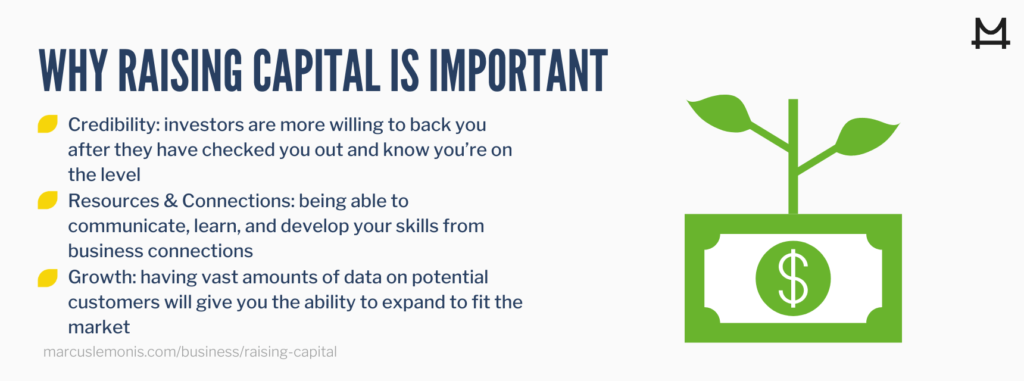
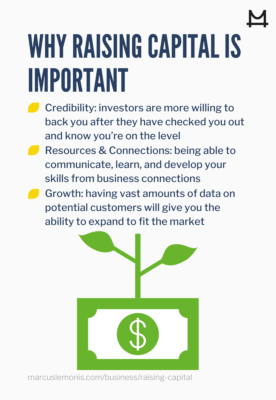
Times are Changing, and so are Investors
Investors aren’t like banks. Their money isn’t a loan. Investors give you capital in exchange for a partial ownership of your business. They want their stake to be profitable. Marcus always says that people work harder when they have skin in the game, and that’s absolutely true for your relationship with your investors.

Communication with Competitors and Investors
It used to be that when entrepreneurs wanted to know how to raise capital, they would have to sit through endless meetings. Nowadays, everything you need to know is a click or two away on the Internet. Search for investors online, see if they have a web presence like a Twitter account, then look at what they say about your market. Similarly, you can watch the progress of your competitors for signs about their next big moves. You can match pace, see where they might run into issues, and even communicate with them about their next moves.
Everything Moves Faster Now, Even Wealth
Technology and investment go hand in hand. Anything can happen in the blink of an eye, thanks to data analytics and market forecasting. What does that mean for an entrepreneur? Well, rapid success if you work hard and choose the right partners. Recent internet and tech entrepreneurs have leveraged modern capital raising techniques and have been rewarded handsomely. These entrepreneurs include Sean Parker, who became a billionaire in only one and a half years thanks to Facebook. Mark Zuckerberg became a billionaire in only four. Pierre Omidyar started eBay in 1995, and 3 and a half years later had three commas in his net worth. (Abadi, 2018). Knowing how to raise capital for business, inspiring fast growth, and hard work have made these guys successes.
What is an Angel Investor, Venture Capital, or Crowdfunding?
You may have heard these terms and not quite understood the difference. Here is a brief rundown of what these terms mean and how to raise capital with each of them.

Angel investors are individuals with large amounts of cash that they use to invest in new, small businesses. Angels usually invest early in the process (when it’s the riskiest investment) and take a larger-than-average ownership stake in the startup they support. They may be very hands-on with their assistance, similar to the way Marcus guides small business entrepreneurs toward success. With Marcus, however, you know no matter how much the investment, he is always “100% in charge.”
Venture capitalists are similar to angel investors, except multiple investors create a firm that can help them share the risk of failure.
Because they pool their money, a venture capital firm or fund can absorb more losses than an individual angel investor. However, these firms usually fund startups with a high chance of massive success so that each investor gets a significant return. VCs also usually invest early in the process, typically after a company has seed money.
Crowdfunding is another form of selling equity in your company to investors. Instead of selling a large chunk to a single entity, you sell many smaller shares to a wide-ranging group of investors. Say, for example, you sell an angel investor 30 percent of your company. With crowdfunding, you could sell 1 percent of your company to 30 different investors for the same amount of capital. There are more advanced articles on how to raise capital for business using crowdfunding, but this should give you an idea of what it is.

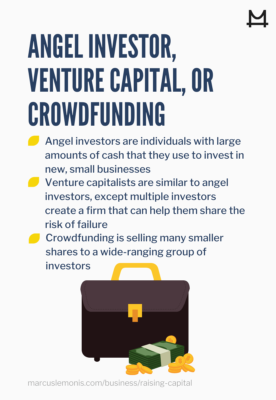
Tips & Tricks for Raising Capital Efficiently
Examine Your Company with a Magnifying Glass
Investors will see your flaws before you do. “At the end of the day, the numbers don’t lie,” as Marcus reminds us. What does your data say about your sales or losses? Where do you need improvement? Where can an investor’s knowledge help you grow? If you know your issues ahead of time, then you can take a head-on approach to fix them.
Cut Out Everything That isn’t Bringing in Money
In order to make yourself appealing to investors, you might have to cut costs. Investors look for profitability and scare off easily if they can’t foresee their investment returning quickly. Spending a lot of time or energy on your passion projects that may take a while to get off the ground is not how to raise capital efficiently. Save the passion projects for later and focus on what brings in the money. This was a tough lesson to learn for the owner of an auto dealership in the Midwest that Marcus went to visit. Instead of investing in more inventory (cars) to sell, this owner spent half of his own 4 million dollar investment to fund his passion project – a luxurious waiting area for customers to hang out. From big-screen TVs and video games to high-end furniture and massive murals, this was more of a wasteful area. Granted, customer experience is important, but none of these things brought in customers or sales. So remember to “Control your cash, stick to your core business, and know your numbers,” says Marcus.

Have a Rainy Day Fund Built Into Your Model
This doesn’t necessarily mean that you should have a safe full of cash. Although, never a bad idea and it is one way to raise capital for business! You just need a secondary way to keep your business moving in case of a stalled economy, a failed round of investment, or even just a matter of bad luck. The three founders of Unity Technology, a gaming technology company that now reports over $300 million in annual revenue, had to keep themselves afloat in the early years by doing consulting work, taking personal loans, and working in cafes before they secured capital funding. (Brodkin, 2013).
Having the ability to unload assets or find other ways of securing funding to keep your company alive should be ready-baked into your model. You should also try to retain as much ownership of your startup as you can, but don’t turn down capital investments if they are needed to keep your head above water. That’s how to raise capital in a way that’s beneficial to you and to your business.
What Kind of Capital do You Need?
Unless you know what kind of capital your business needs, you can’t learn how to raise capital. You need to know your numbers and how each form of investment in your business will change your model.

Seed capital is the initial money you use to develop your business plan or new product. Seed capital usually only takes care of the initial proposal. After the seed stage, most startups look for more money from VCs or loans to fund the actual building process.
Venture capital is usually the second step in how to raise capital for business. If a VC or an investor is impressed by the idea you funded with your seed money, they may choose to invest in your company for a cut of ownership. This is where startups receive a large cash infusion to pay for product development, market research, prototyping, building an office, etc.
Mezzanine capital is how established companies raise money for projects or cover a business merger’s cost. It is used to help a company grow. Startups don’t usually use mezzanine capital, but it’s important to be knowledgeable about these terms.
IPO stands for initial public offering. This is when your company is ready to become publicly shared. Instead of all of the shares belonging to you and your investors, you offer them for sale to the public on a stock exchange. If your business meets SEC requirements, you can gain a lot of equity through an IPO.
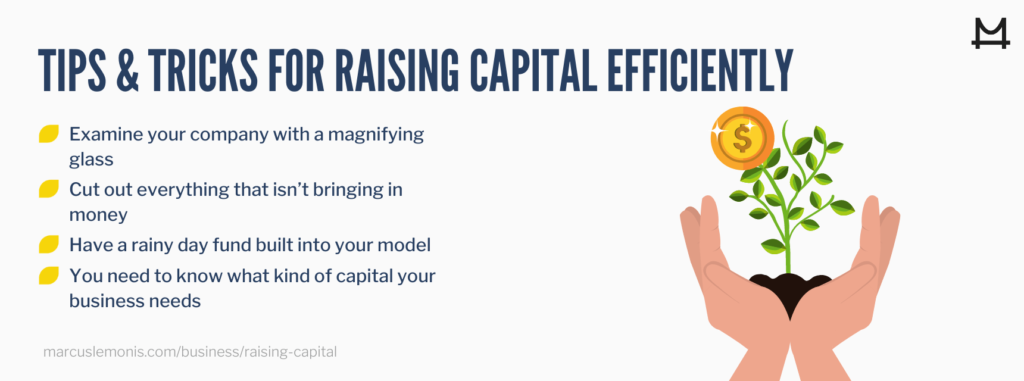
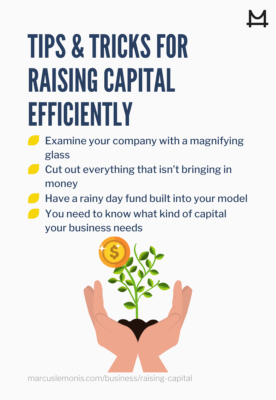
Take a breath, make a plan, and do the work.
Investors are people who want to see your company succeed. But, let’s face it. Your small business is your dream, so it’s scary to bring in new investors. Keep in mind what Marcus always says, “The definition of an entrepreneur to me is the willingness to fail, and it takes a lot of guts and a lot of heart to take that chance.” You can learn how to raise capital for business just like so many other successful entrepreneurs before you. Know your numbers, choose the right form of investment for your company, surround yourself with good people, and get out there and work.
This article is informational only and subject to errors or omissions. As with any legal or regulatory advice, please consult your legal counsel or tax advisor to make sure you are in compliance with all and any federal, state, city or county rules and regulations. More
- What are some things your business currently does to raise capital?
- What tips from above can your business utilize to raise capital now?
Abadi, M. (2018, April 14). 17 people who became billionaires with the least amount of work.
Retrieved from https://www.businessinsider.com/billionaires-fortune-earned-fast-2018-4Brodkin, J. (2013, June 3). How Unity3D became a game-development beast.
Retrieved from http://insights.dice.com/2013/06/03/how-unity3d-become-a-game-development-beast/Wood, M. (2020, February 3). Raising capital for startups: 8 statistics that will surprise you.
Retrieved from https://www.fundera.com/resources/startup-funding-statistics





